As part of a new series of blogs on the history of buildings in Eldon Street, Dr. Tegwen Roberts (HAZ Project Officer) and David Blunden (Community Sector Specialist) take a look at 12-18 Eldon Street, the former YMCA building, including some of the former occupants of the building, the community facilities offered by the YMCA who originally built the property, and the recent repairs and renovations funded by the Eldon Street High Street Heritage Action Zone.
Early history of 12-18 Eldon Street
The early history of the building can be traced back to 1907, when the Trustees and Committee of the Young Men’s Christian Association (YMCA) submitted a building plan for a new purpose-built Barnsley headquarters with three separate shop units on the ground floor. The Barnsley branch of the YMCA had been established 11 years previously, and had occupied rented premises on Sheffield Road, George Yard and Back Regent Street (now Regent Street South) before taking the decision to create a purpose-built headquarters to grow their membership and provide a ‘safe place’ for young men to socialise and develop important life skills away from the town’s public houses.
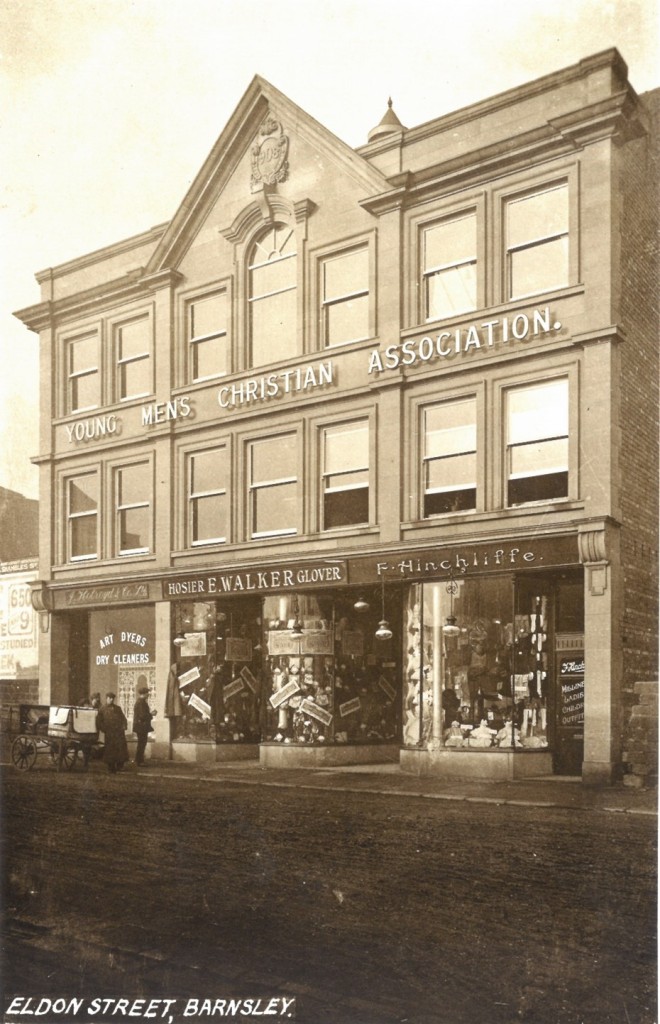
The plan was approved by the local council and the foundation stone was laid by the right honourable Lord Arthur Fitzgerald Kinnaird, president of the YMCA and one of England’s first football stars, on 3 July 1908. His visit caused some excitement, and was reported in the local papers. The building was referred to as ‘YMCA Buildings’ in early advertisements, but officially it was numbered 12-18 Eldon Street, with the YMCA itself being at number 16.

The building was officially opened on 4 January 1909, an event that was commemorated with a Warner Gothard ‘montage’ postcard. Warner (junior) and his siblings pioneered the multi-imaged postcard and had a photography studio close by on Eldon Street, which may explain their interest in the event. The site of the new building had previously been part of the yard of the King’s Head Hotel. Initially the new property stood alone and would have been in a very visible location in the centre of Barnsley. However, this did not last for long. Eldon Buildings was built next door the following year, in 1910, to a strikingly similar design.
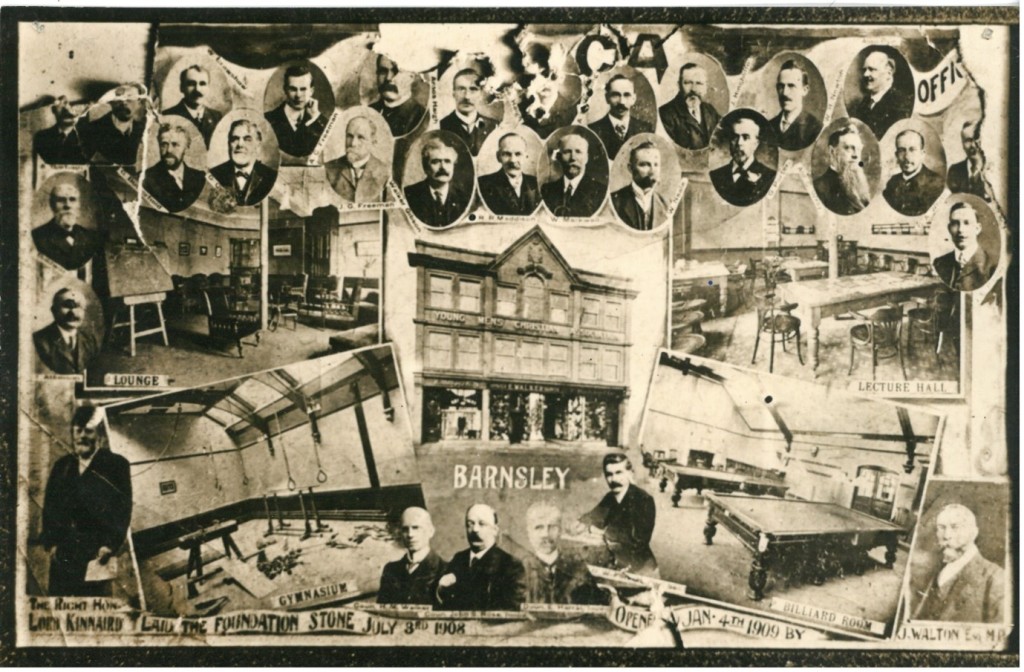
The original plan of the building included a kitchen, lounge and social area on the first floor, reading rooms, a meeting room, billiard room (on the top floor), games rooms and a dark room studio, along with three shops on the ground floor (12, 14 and 18 Eldon Street) that were rented out separately. There was also a lecture hall on the ground floor, behind the shops, which doubled up as a gymnasium. This had skylights to let in natural light. The building embodied the YMCA’s guiding principles of helping young men to develop healthy ‘body, mind and spirit’. On the front of the building above the first floor in bold lettering was ‘YOUNG MENS CHRISTIAN ASSOCIATION’. The entrance to the YMCA rooms was via a central passageway and staircase from the ground floor between the shops on Eldon Street.

Newspaper coverage of Lord Kinnaird’s visit in 1908 reported that the total cost of the project, including buying the land, was £7000. £2000 was to be raised in public subscriptions and the rest to be funded by a mortgage and Debentures. The newspapers also reported that the building was designed by Mr E W Dyson and was to be built of brick with a polished Yorkshire Stone front. Recent renovation works suggest that the original bricks were sourced locally from Summer Lane brick works, less than a mile from Eldon Street.
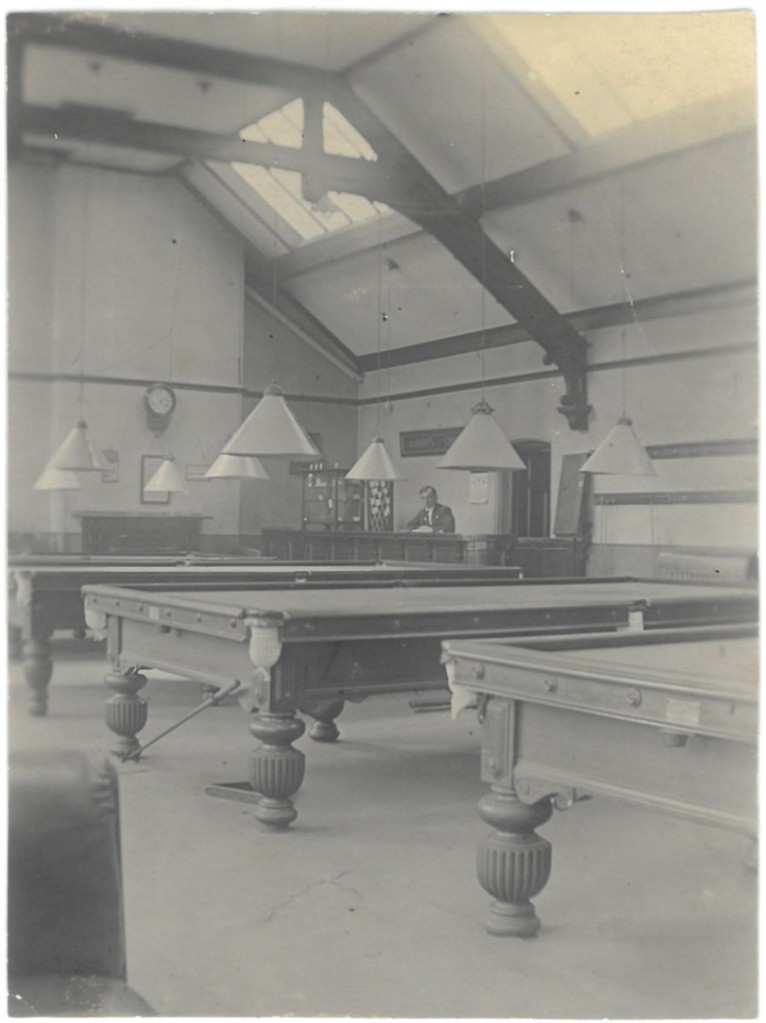
The YMCA held a wide range of activities in the new building, including bible classes, Sunday school, evening classes on moral philosophy, elocution and Esperanto, a male voice choir, music and dance classes, gymnastics, billiards and games clubs, sports groups, a rifle club, a photography club, Sunday night concerts and evening socials. The reading room was open from 8am until 10.30pm, and there was cycle storage available on site. From the mid-1920s the YMCA also ran a popular operatic and theatre society and put on regular productions at the Public Hall. Membership in the early years was 5 shillings a year for members aged 16-21, and 8 shillings a year for members over 21.

The building inevitably changed and developed over time. By 1960s the large central pediment had been partly removed, possibly for safety reasons, and internally the layout of the building had changed to include a canteen, television rooms and a table tennis room. In fact, the YMCA had a very strong local table tennis side who won the top division in the Barnsley League during the 1954-1955 season and had six teams overall, playing in all divisions during the 1950s. Perhaps some of our readers remember playing or going to watch a match there?
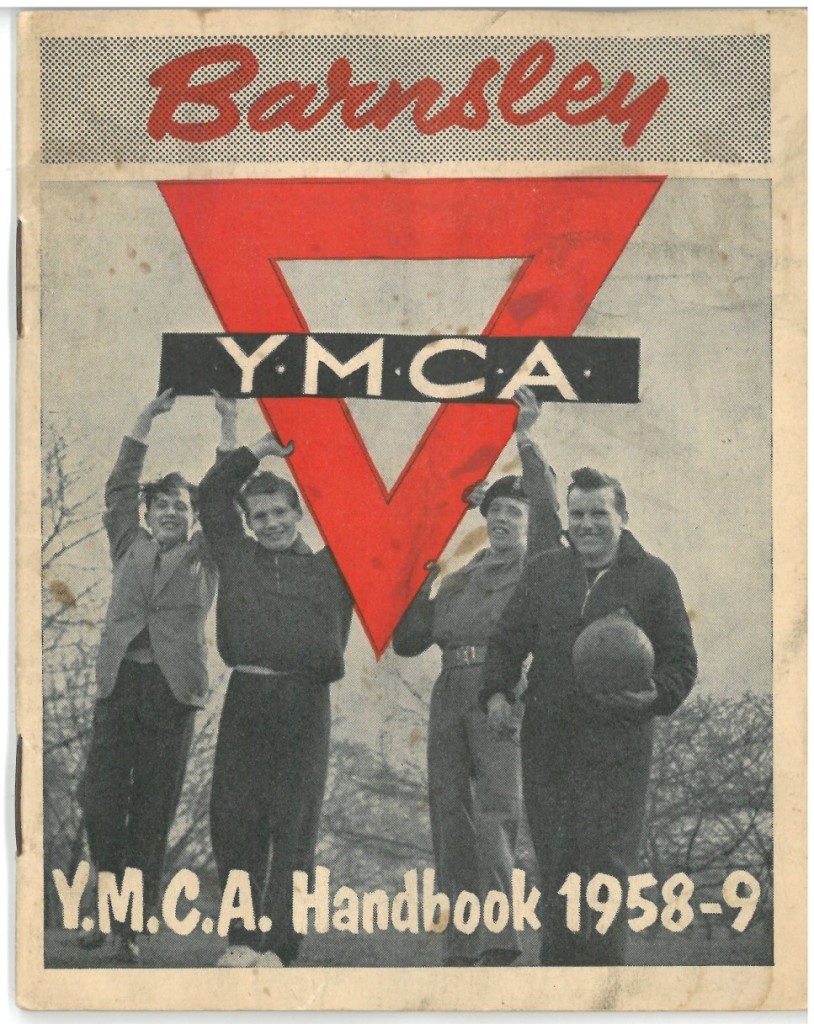
The YMCA relocated to new premises at the corner of Blucher Street and Pitt Street in 1965. The new building was officially opened on 3 June of the same year by the Countess of Harewood. 12-18 Eldon Street is currently being renovated with the support of the Eldon Street High Street Heritage Action Zone.
12-18 Eldon Street shop stories
The original retail units on the ground floor had beautiful, curved glass windows and well-proportioned shopfronts with matching pilasters at either end. The first tenants were all connected with clothing; Holroyd Dyers and Dry Cleaners (number 12), Ernest Walker’s gloves and hosiery shop (number 14) and Hinchliffe’s milliners (number 18) who all opened in 1909.

The Barnsley branch of Holroyd’s (at number 12) continued to operate from the YMCA building until the 1930s. Ernest Walker’s (at number 14) advertised luxury brands. This advert appeared on the front page of the Barnsley Chronicle during 1911-1912 (Aquascutum and Burberry’s are still well-known clothing brands. Gandabak was a type of rainproof coat, and Dexter was another brand of weatherproof clothing).
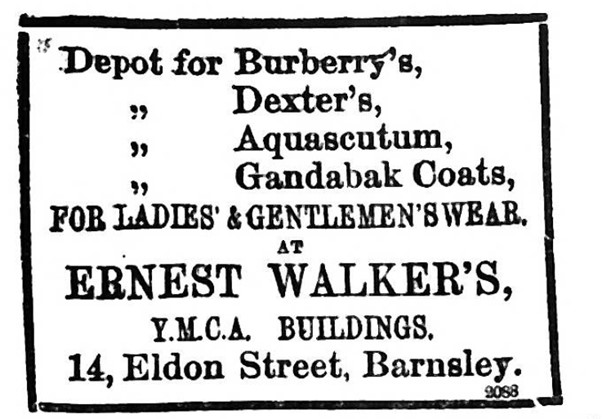
Hinchliffe’s was the shortest-lived of the original tenants, lasting less than a year. It was replaced in 1910 by Harry Scargill’s drapery business.

Harry Scargill was one of the first to volunteer for the 1st Battalion of the Barnsley Pals regiments at the outbreak of World War One. On embarking for the front in 1914, he published a notice in the Barnsley Chronicle that he was leaving his business on Eldon Street in the hands of his younger sister Miss Annie Scargill.
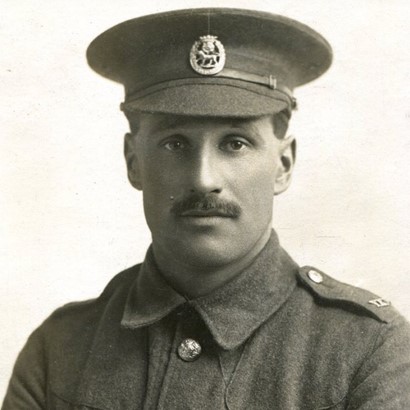
Sadly, like many others, Harry did not return from the war. By then a sergeant, he was one of many in the Barnsley Pals regiment who was killed at the Somme on 1 July 1916, and is commemorated on the Light Lines memorial now located in Churchfield Peace Gardens. He was 28 when he died. As a consequence, Annie Scargill became the proprietor of the business at 18 Eldon Street, which she ran as a Ladies Outfitter’s until shortly after she got married in 1925 (with the business closing in 1926).

The longest standing shop in the YMCA building was Timpson’s shoe shop. They replaced Ernest Walker at number 14 in the early 1930s and then later in the decade enlarged the shop by taking over number 12 after Holroyd’s left. During the mid-1960s they also occupied number 18 for the shoe repair part of the business. By the late 1970s Timpson’s shoe shop had moved to May Day Green and Hurst Linens took over the lease for numbers 12-14. They were followed by Famous Army Stores (clothing) from the late 1980s until the early 2000s. Other national businesses at number 18 have included Halfords (cycles), Ray Alan (menswear) and Alliance and Leicester (banking).

High Street Heritage Action Zone
The building was sold in 2022. In 2023 the Eldon Street High Street Heritage Action Zone awarded a grant to the new owner of the building to support a programme of renovation works, including reinstating more sympathetic shop fronts along Eldon Street, repairs to the roof and historic stonework and conversion of the interior of the property to a new commercial use. The building is due to reopen in early 2024.
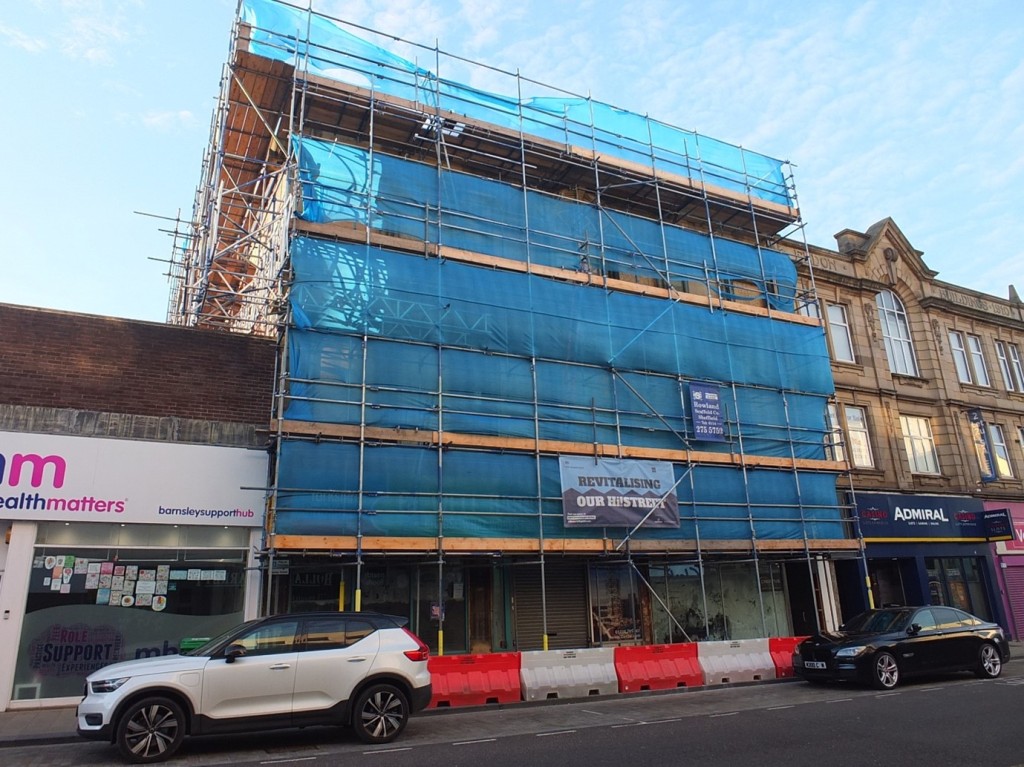
HSHAZ funded works underway in May 2023
The High Street Heritage Action Zone is a 4-year partnership project funded by Barnsley Council and Historic England and is helping to rejuvenate Eldon Street in Barnsley Town Centre. It is led by Barnsley Museums and is due to finish in March 2024. With thanks to Paul Reed and Kevin Scargill for kindly sharing their research on Harry and Annie Scargill.

